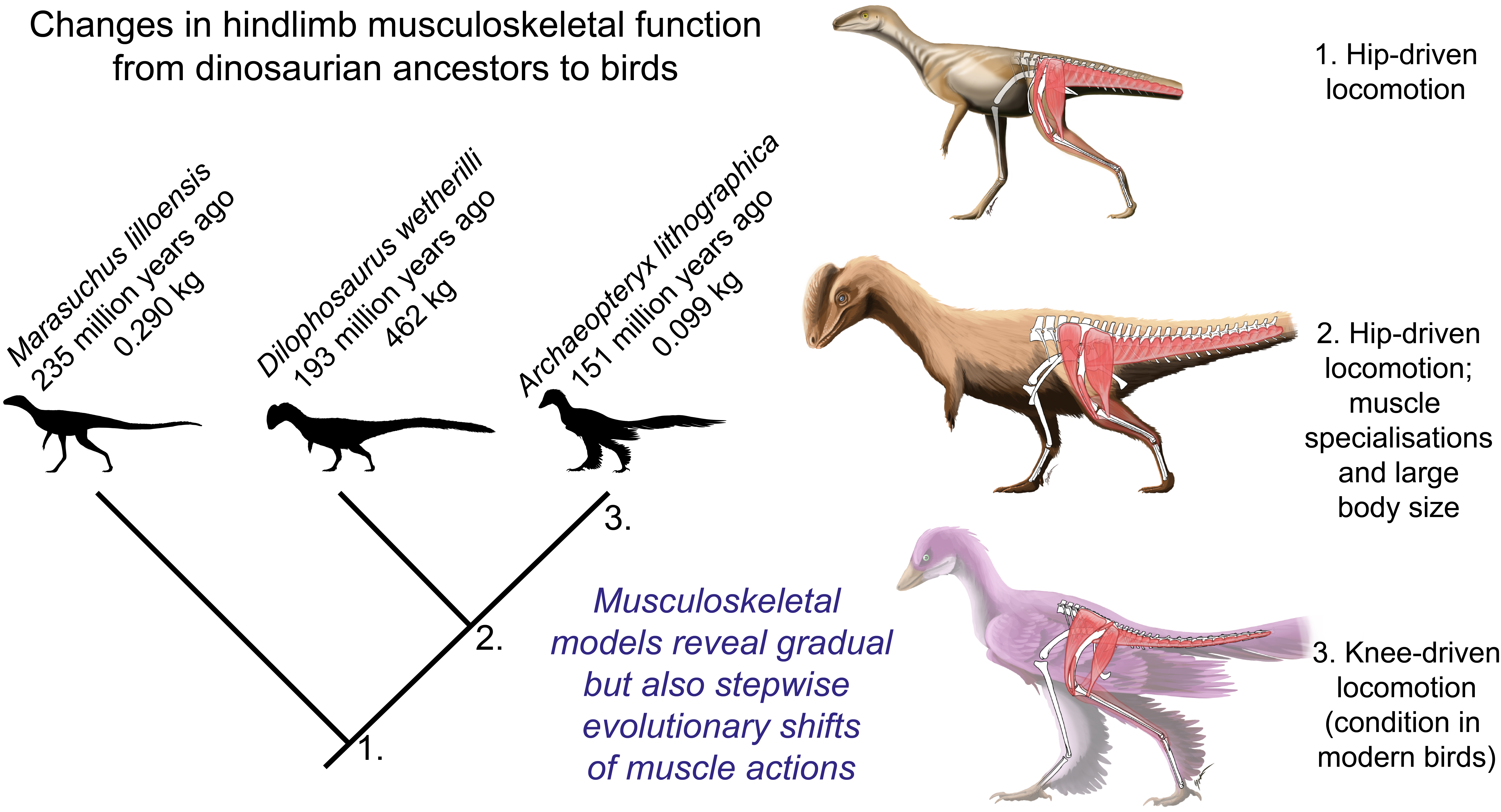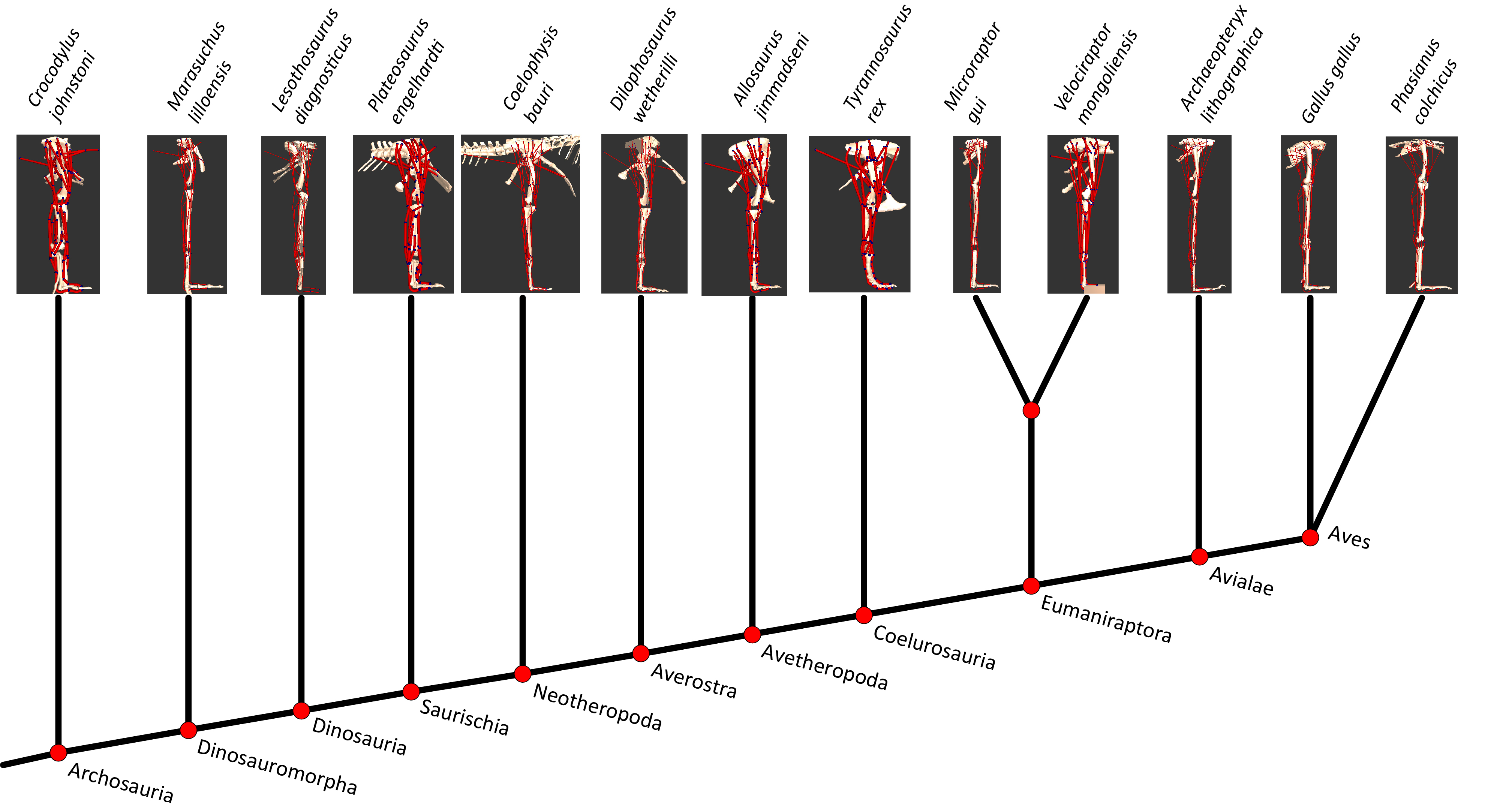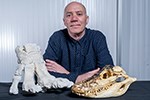Biomechanical models unlock muscle-bound secrets of the evolution of dinosaur locomotion
Scientists have discovered how the locomotion of dinosaurs on land changed from the earliest, cat-sized bipedal (walking on two hind legs) forms to giants like Tyrannosaurus rex and then ultimately birds.
The findings identify that movement in birds and their non-avian dinosaur ancestors differs significantly, consistent with the idea that the locomotion of early dinosaurs was more comparable to mammals like humans than to birds. The ground-breaking study used 13 three-dimensional biomechanical computer models to reveal how the functions of 35 leg muscles in dinosaurs evolved over approximately 230 million years.

Pictures by palaeoartist Jaime Headden
The study, which was published today in Science Advances, was conducted by researchers at the Royal Veterinary College (RVC), working with Dr. Brandon Kilbourne of the Museum für Naturkunde Berlin, Germany. The team scanned key fossils of dinosaurs into 3D models and connected the bones into digital skeletons. They then added muscles to their hindlimbs, based on extensive prior work identifying where these muscles attached, through examination of the scarring on the fossils as well as comparisons with living animals. The computer models then computed the leverages (mechanical advantages) of muscles around the joints, and statistical analyses plotted the changes of these functions throughout dinosaur evolution.
The researchers discovered that the ability of the hindlimb muscles to support and move the body changed drastically before and during the transition to birds. Hip muscles changed in complex ways but overall, facilitated the more crouched leg pose characteristic of birds (versus a relatively upright pose in early dinosaurs; similar to in humans). Knee muscles also reflected these changes, from a “hip-driven” early locomotor mode - as seen in living crocodiles - to a more “knee-driven” one, as seen in birds today. The most surprising discovery was that relatively large-bodied, carnivorous (theropod) dinosaurs using two hind legs for walking, throughout the early Jurassic Period (about 200 million years ago), evolved an unusually specialised suite of muscle functions correlated with more mobile leg joints which might have been related to taking on larger prey; unlike in the later bird-lineage.
Carrying out this research has both confirmed and shed further light on a prevailing idea regarding how dinosaur locomotion evolved. It was thought that, as dinosaurs reduced their tails and enlarged their forelimbs in species closer to birds’ ancestry, the pose of the legs gradually became less upright and more crouched, thus transitioning from a hip-driven to knee-driven mechanism of walking and running. The computer models show how individual muscles broadly fit this pattern of gradual evolution. However, the finding of specialisations in large-bodied theropod dinosaurs uncovered a fascinating “re-invention” of parts of this mechanism of leg function that did not simply fit the gradual “more bird-like” pattern. The team interpreted this re-invention to be a phase of locomotor evolution that became reversed in the later bird lineage.
In current follow-on studies, Professor John Hutchinson’s team at the RVC is using such biomechanical models in simulations to predict how individual species moved in terms of efficient walking, maximal-speed sprinting, jumping and turning; and thereby how athletic performance evolved in dinosaurs and their relatives (see www.dawndinos.com for information).

Dr John Hutchinson, Professor of Evolutionary Biomechanics at the RVC, commented:
“This study is a pivotal moment in my team’s research, connecting the dots between fundamental research I began over 25 years ago. This includes reconstructing where leg muscles attached in dinosaurs, to later simple two-dimensional biomechanical models of locomotion, and eventually investigating three dimensions too. Now we have been able to explore evolutionary timescales across 13 models of important representative species; opening up big new questions about how locomotor biomechanics evolves at the level of 35 individual muscles. It was a huge amount of work that is really satisfying to complete.”
Second author Dr Brandon Kilbourne, researcher at MfN Berlin, commented:
“The style of locomotion in birds and their non-avian dinosaur ancestors is radically different; so different that the locomotion of early dinosaurs has been suggested to have been in some ways more comparable to mammals than to birds themselves. Through musculoskeletal modelling, we charted over 230 million years and assessed the evolutionary transformation of how the knee came to have a central role in the terrestrial locomotion of the roughly 10,000 species of birds alive today. By looking at the changes in the three-dimensional leverage of 35 muscles over hundreds of millions of years, we have a clearer picture of this transformation – and its complexity – than ever before. Though the modelling posed quite a challenge, the payoff in terms of novel insights has undoubtedly exceeded the effort.” The research was funded by the European Union’s Horizon 2020 research and innovation program via a grant to Professor John Hutchinson (RVC), by the RVC, and by a grant to Professor Hutchinson from the UK’s Natural Environment Research Council.
Notes to Editors
Images, captions and graphical abstracts available here: https://www.dropbox.com/sh/o0fgzjtvucm0mfq/AADFYGwCbUtEdSBJSSmH1TrZa?dl=0
Reference: V. R. Allen, B. M. Kilbourne, J. R. Hutchinson, The evolution of pelvic limb muscle moment arms in bird-line archosaurs. Sci. Adv. 7, eabe2778 (2021).
The full paper is available from Science Advances - DOI: 10.1126/sciadv.abe2778
For more information please contact:
- Jasmin De Vivo (Jasmin.DeVivo@plmr.co.uk or rvc@plmr.co.uk
- Press Line: 0800 368 9520
About the RVC
- The Royal Veterinary College (RVC) is the UK's largest and longest established independent veterinary school and is a Member Institution of the University of London. It was the first in the world to hold full accreditation from AVMA, EAEVE, RCVS and AVBC.
- The RVC is the top veterinary school in the world according to the QS World University Rankings by subject, 2021.
- The RVC offers undergraduate and postgraduate programmes in veterinary medicine, veterinary nursing and biological sciences.
- In 2017, the RVC received a Gold award from the Teaching Excellence Framework (TEF) – the highest rating a university can receive.
- A research led institution with 79% of its research rated as internationally excellent or world class in the Research Excellence Framework 2014.
- The RVC provides animal owners and the veterinary profession with access to expert veterinary care and advice through its teaching hospitals and first opinion practices in London and Hertfordshire.
You may also be interested in:
-
RVC’s Professor John Hutchinson elected Fellow of prestigious Royal Society
John Hutchinson, Professor of Evolutionary Biomechanics at the Royal Veterinary College (RVC), has …

